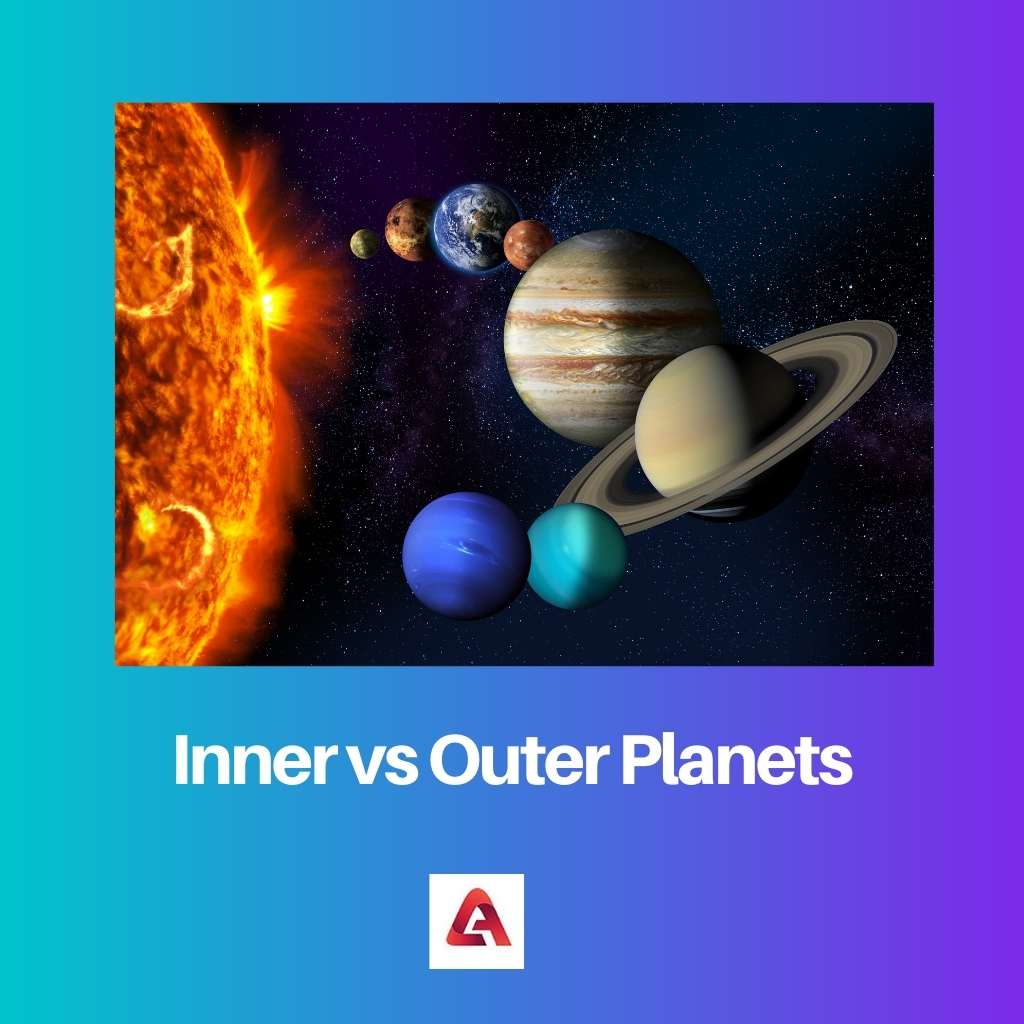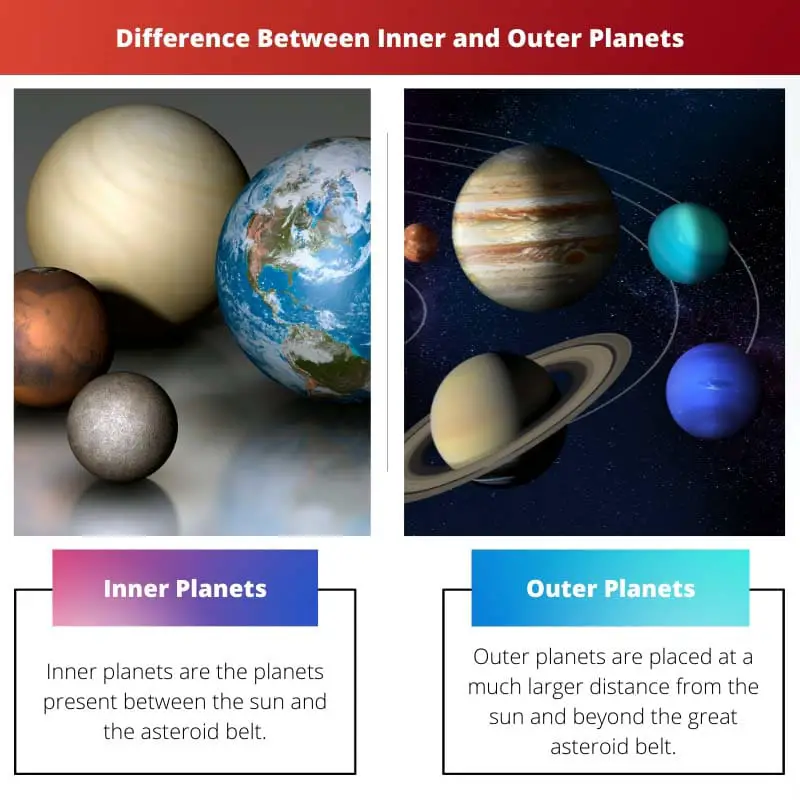Our solar system is divided into inner and outer planets based on a few differences. Humans have always been interested in the intergalactic world and have always tried to gather as much information as possible.
Now we know more about the galaxy than ever and can easily distinguish between the two types of planets.
Key Takeaways
- Inner planets (Mercury, Venus, Earth, and Mars) are rocky and terrestrial, while outer planets (Jupiter, Saturn, Uranus, and Neptune) are gas or ice giants.
- Inner planets are closer to the Sun and have shorter orbits, while outer planets are farther away and have longer orbits.
- Outer planets have more moons and complex ring systems, whereas inner planets have few or no moons and lack rings.
Inner vs Outer Planets
The inner planets, Mercury, Venus, Earth, and Mars, are small, dense, and rocky. They have shorter orbital periods, taking between 88 and 687 days to complete one orbit around the Sun. The outer planets are larger than the inner planets and have longer orbital periods, taking between 12 and 165 years to complete one orbit around the Sun.

Inner planets are the planets present between the Sun and the asteroid belt. This closer association with the Sun gives the planets a pretty hot or humid planet temperature making some of them not suitable for the survival of organisms.
This planet’s temperature determines many other factors in the inner planets, such as the terrain and the way the planet has been formed.
Outer planets are placed at a much larger distance from the Sun and beyond the great asteroid belt. These planets have attained a great drop in temperature due to the distance from the Sun.
Such a drop in temperature affects the general aura around the planet, creating a massive difference in the planet’s terrain and atmospheric growth.
Comparison Table
| Parameters of Comparison | Inner Planets | Outer Planets |
|---|---|---|
| Planets In The Galaxy | Mercury, Venus, Earth, and Mars | Jupiter, Saturn, Uranus, and Neptune |
| Density | Higher | Lower |
| General Composition | Rocks | Inert gases |
| Revolutionary Period | Short | Long |
| Distance From Sun | Very small in comparison | High |
What are Inner Planets?
The inner planets in the Milky Way are Mercury, Venus, Earth, and Mars. Inner planets are all placed in their orbits around the Sun and are in the galactic space between it and an asteroid belt.
This means their position in the Milky Way is closer to the Sun than most other things in space. Being this close to the Sun gives the planets a significant advantage in many cases.
The higher temperature has led to the formation of a species inhabitable environment on our planet Earth. The greater temperature has also helped create different surface types unique to each of the four inner planets.
All the inner planets have a rocky terrain accompanied by the gradual formation of mountain or hill-like structures and valleys. The primary composition of the inner planets is all minerals and inert elements like silver and platinum.
The surface of most of the inner planets is rich in silicon and iron, thereby helping scientists come up with specific speculation. This speculative thinking is that all the inner planets have a core with iron content in molten iron.
This has given the inner planets another name, terrestrial planets. The periods of revolution around the Sun are low as they are close to the Sun.
The planets tend to have a higher density as the primary component in all the worlds is rocky in structure. The orbits that the terrestrial planets revolve around are closed and therefore revolve in a completely elliptical form.
The fascinating thing about the inner planets is that despite being similar in all properties, the general environment of each world is unique.
The surface of each planet, and the atmospheric thickness and composition, are all different for the inner planets. While Earth plays host to water, no traces have been found on any other inner world.
The spin of each planet around its axis tends to be slower in their case. The inner planets possess minimal moons, with Earth having a single moon.

What are Outer Planets?
The outer planets are Jupiter, Saturn, Uranus, and Neptune. The position of the outer planets in the galaxy is much beyond the asteroid belt.
Due to their considerable distance from the Sun, the outer planets are pretty cold, and the atmospheric temperature is below zero.
These planets are composed of inert gases such as helium. This inertness of the gases affects the general environment of these planets.
Some planets are more significant in acidic content and can therefore be dangerous for survival if not protected extensively. The outer planets’ revolution period tends to be much more significant as their distance from the Sun is equally big.
The planets are very low in density, and their densities can be considered equal to or less than that of water. Outer planets are also commonly called Jovian planets. This name concerns one of the major outer planets that are Jupiter.
The orbits of the Jovian planets are all broken; therefore, the planets do not always form a proper ellipse while rotating around the Sun. It isn’t typical for all the outer worlds to have the same composition, as they are all made up of different gases.
The atmosphere is considered strongly magnetic and has a tremendous storm-like centre due to the tremendous magnetic fields present in the atmosphere.
The planets’ low temperature and intense gravitational pull keep the atmosphere intact as it is gaseous. The worlds experience a bad hurricane which is termed the Coriolis effect, that can be seen from the Earth.
The Great Red Spot in Jupiter and the Great Dark Spot in Neptune are two clear examples of the Coriolis effect.

Main Differences Between Inner and Outer Planets
- While the inner planets are found between the Sun and the asteroid belt, the outer planets are well beyond the belt and at a greater distance from the Sun.
- The outer planets have more moons of varying sizes, while the number is small for the inner planets.
- The orbits of the outer planets are not a complete ellipses and are broken, while the orbits of the inner planets are a complete ellipse and therefore give them a shorter period of revolution.
- The general composition of all the inner planets is the same and is rocky, while the composition of the outer planets, even though it is all gas, the types of gases vary.
- The density of the inner planets is much greater than the outer planets.




